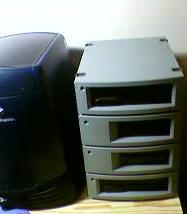R-ten-K wrote:
I think the feature I remember was their odd cache strategy: usually they implemented a single very large cache level.... And now that you brought the handler issues, it makes a lot of sense to have a big honking cache when so much overhead is expected when servicing interrupts, exceptions, etc.
Yeah, even today, the last generation PA-RISCs have 32 and 64Mb L2 caches. I'm not sure why they do that.
R-ten-K wrote:
It must have been weird to be motorola in the 80s, everyone leaving you for yet another RISC vendor.
I was at Motorola in the 90's and they were still in the process of moving 68k based UNIX boxes used internally to competitors CPU's (mostly PA-RISC). All the 68k based Macs were being replaced as well, but at least they had a stake in PowerPC, so it wasn't all bad.
hamei wrote:
While we've got you two dissecting the shortcomings in processors, how about the Power lineup ? And where does the Itanic
really
fit in ? Would it have been the processor to end all processors if it hadn't been such a bust ?
I have never really used POWER systems - I've only read some of the papers on POWER and AIX. It is actually a couple of similar architectures in one (to support old POWER 32 & 64 bit, PowerPC-AS, PowerPC 32 & 64 bit). Plus it has great virtualisation support (in combination with firmware), and they have also started to implement hardware assists for commonly needed stuff at OS level. And it achieves decent clock speeds. All in all, a nice chip, and a shame it isn't being used more widely.
Ahh. Itanium
... take many PA-RISC features (already overly complicated from an OS point of view)
... add things like register window concept from SPARC, some of MIPS CP0 features, the PALcode idea from Alpha,
... add a huge number of registers, so that normal context switching strategies are not feasible. Ensure that lazy strategies are needed, and thus complicated stack unwinding is needed when something needs to access the register file of a suspended thread.
... then implement full IA-32 compatibility in hardware (i.e. one of the most complicated and kludged architectures ever).
... then for the ISA, use an explicitly parallel design that puts a massive burden of work on compiler writers (and also those writing assembly for the kernel and libraries).
I was never impressed with it from the start, and wasn't the least bit surprised that what seemed like the underdog (AMD Hammer, now AMD64) took the role expected of the mighty Itanium in the 64-bit world. Its actually funny - I recall around 1999 or so seeing graphs projecting annual shipment of 30 million itanium based systems just a few years later. Its a shame several decent architectures (Alpha, and MIPS to an extent) got killed off for what turned out to be a commercial flop. Admittedly it did do FP well, and scientific sales are probably the only thing that justifies keeping it alive nowadays.



